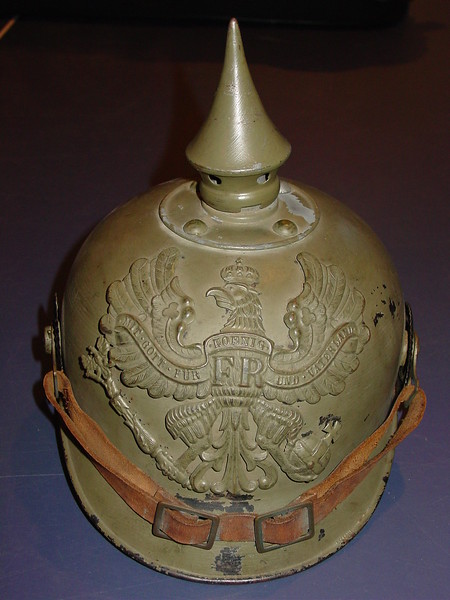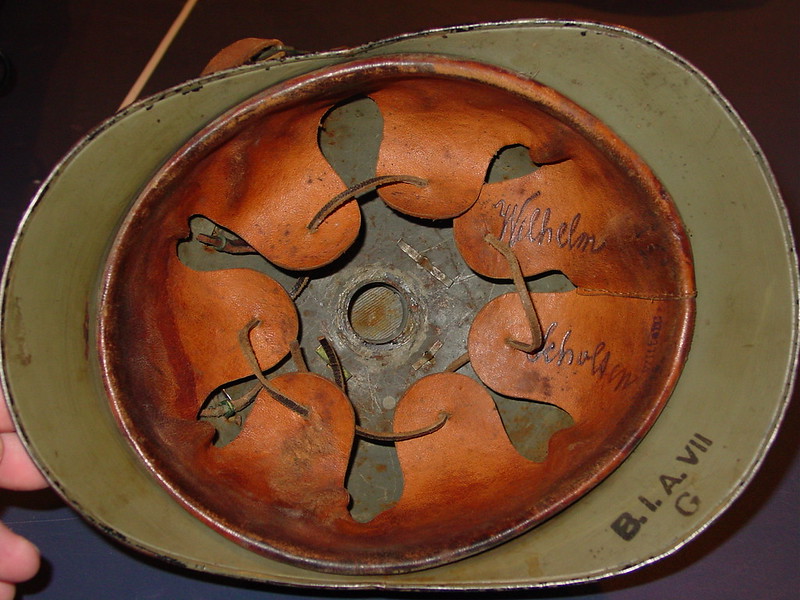Hi pickelhauben.
Just read through my post and "holy wall of text Batman!"; please bear with me.

I did not mean to be so "wordy" when I started this...
I have an ersatz helmet made by the same maker as yours. The shell and spike are identical to yours. The only difference that I recall is that mine is painted black, has a Bavarian front plate, has split brads holding the liner in place front and rear rather than the larger rivet on yours, and has a natural leather colored liner similar to the examples some of the other members have posted.
I believe one of the members said that he thought your liner might be French or Belgian, which I think could possibly be the case. It may have been replaced by someone in the intervening 100 years since it was made.
My observations, for what they are worth, is that these are original, but made by a different manufacturer than the other ones posted. Or, potentially, the same manufacturer but during a different period, or under an earlier or later contract.
I used to own an example like the other members have posted and compared both types side by side years ago. The example you posted is stamped out differently/used a different die, hence, the lack of rough die ridges spiraling around the crown of the helmet that many members liken to having the helmet "spun" on a lathe during manufacture. My example, like yours, was polished smooth during manufacture prior to being painted. I have always been of the opinion that these light ridges on the other helmets posted by members were deliberately left on the shell from the die in order to allow the field gray paint to maintain a dull subdued color when worn in the field and to keep the paint in place during rough handling.
Another thing that jumps out right away between your helmet and the ones other members posted is the placement of the domed split brads that secure the spike to the crown. Your helmet has them in the standard form that most pickelhauben were manufactured in; front-to-rear and side-to-side. The examples shown by the other members have the domed split brads in the crown set cross-wise along the axis of the crown. My helmet has the spike brads set in the crown like yours.
Mine also has a small number stamped into the crown if I recall.
I wish I could post photos of my helmet for you to compare but I am stationed overseas right now and my entire collection is boxed up and stored at some property I own Stateside. Hopefully, Gus doesn't figure out where they are at and shows up with his truck.

I will try to find the helmet and get you some photos posted for your use when I go home for Christmas Leave in December, so keep a weather eye out for another posted reply on your topic from me around that time or early January.
Background on the helmet like yours that I own is that it came from a very old collection of a gentleman who picked up most of his spiked helmets in the 1950s and 60s when they could be had for a song. When my mom dragged me to her ladies meetings when I was a kid at this house, this gentleman or his wife would hand me a feather duster and let me hang out in the "helmet room" until the meeting was over. I think that is when I got the pickelhaube bug. The helmet I own was one of them that I purchased after he passed. Tony Schnurr grabbed a couple of those helmets off of that pile as well. I guess I'm trying to say that if these types of helmets are fakes, then they are really, really old fakes. I think they are good, and have held a couple of others like them over the years.
Could you get a couple of pics with the liner carefully pulled up a little? Interested if there is a stamped number in the crown of your helmet like mine and I would like to see how the M91 side posts are mounted on your helmet. I have always assumed the number in the crown (I think it was an 8???) was a die number from the stamping run.
Thanks for showing your helmet and Semper Fi.


















